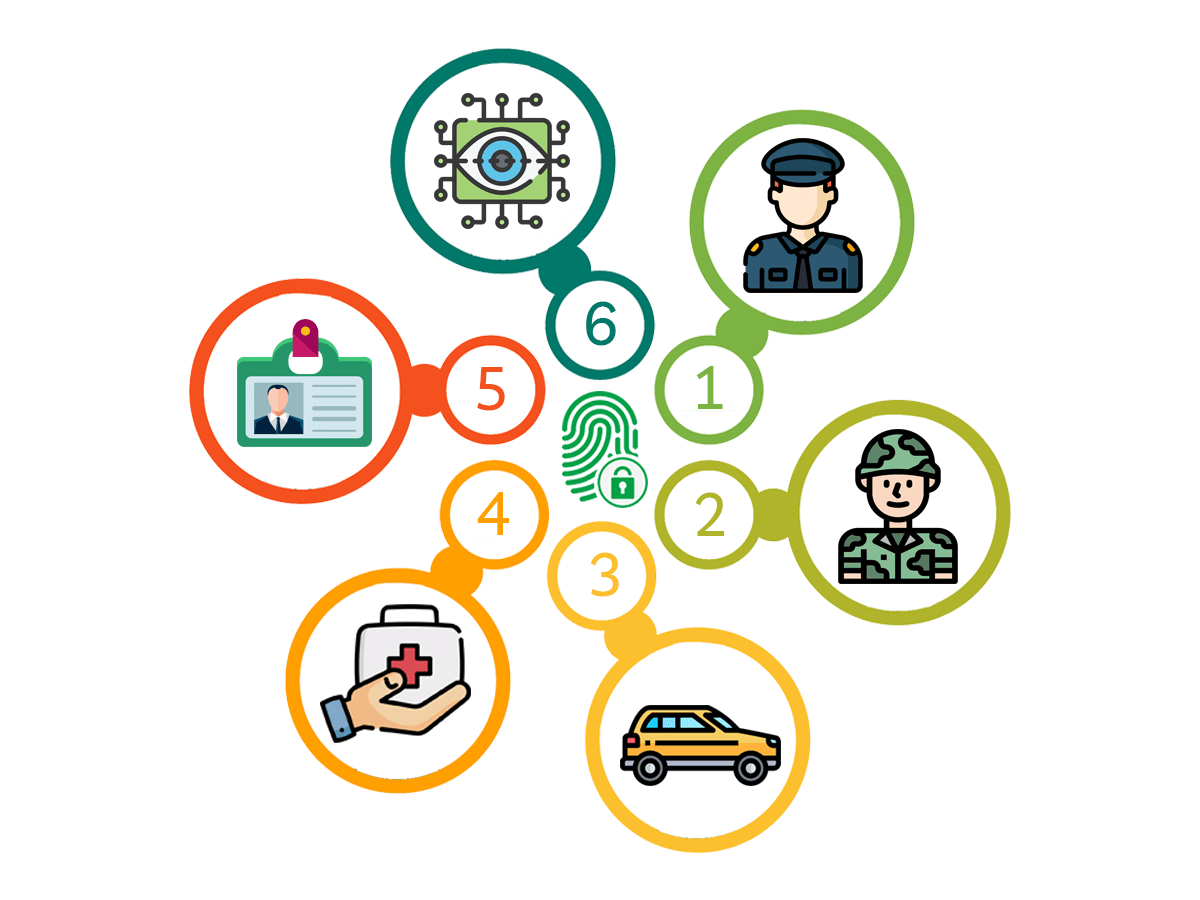Biometrics offers a great & quick way to identify and authenticate individuals most reliably using the most unique biological characteristics like fingerprints, facial characteristics, eye contact etc. It works on a reference model that is stored in secure portable element like a smart card. This data is stored and compared to the person’s biometric data which is available to be authenticated when required.
With the increasing fraud and identity theft through terrorism or cybercrime, there appears a need of implementing the most secure & strong technological solutions. In recent years, Biometrics has emerged as the most pertinent technologies to authenticate identity and prevent fraudulent activities.
This blog is all about explaining the accuracy as well as reliability features of Biometrics, its uses in major business domains & the Biometric trends you’ll witness in 2021 and beyond.
Features & Categories of Biometrics
Biometrics analyzes the physical or behavioral characteristics specific to each individual and uses those to authenticate their identity. There are two categories of biometrics:
Behavioral measurements
Inside behavioral, the most common characteristics are voice recognition, signature style, keystroke dynamics, the way objects are used, the sound of steps, gestures, etc.
Physiological measurements
Physiological characteristics include features such as morphological or biological. These consist of fingerprints, hand & fingers shape, veins in pattern, the eye (iris and retina), and the shape of the face. DNA, blood, saliva, or urine are used by the forensic teams for biological analyses.
Major Business Domain Making Use of Biometrics

With the increasing cybercrime and fraud, sectors like banking, retail, and mobile commerce are highly using the functionalities of Biometrics.
Application of Biometrics is already been seen in the mobile industry with millions of Smartphone users unlocking their phones with fingerprint or face detection.
Here are the top industries that are making this technology on a wider scale:
#1 Law enforcement and public security
Law enforcement biometrics refers to applications of biometric systems that support law enforcement agencies to detect crime and suspect identification.
These include criminal ID solutions such as Automated Fingerprint (and palm print) Identification Systems (AFIS) that store, retrieve, & search fingerprint images and records.
Automated Biometric Identification Systems (ABIS), today, are emphasizing creating and storing biometric information that matches biometric templates for the face, finger, and iris. Many countries are already using these surveillance systems to detect criminals and other fraudulent activities.
#2 Military (enemy identification)
Most militaries across countries have been collecting faces, irises, fingerprints, and DNA data in a biometric identification system to authenticate persons.
The Defense Forensics and Biometrics Agency (DFBA) is managing a system called DoD Automated Biometric Information System. As per the revealed data related to this system, in the first half of 2019, biometric identification has been used thousands of times to identify non-U.S. citizens on the battlefield.
#3 Travel and Migration
Biometrics is widely used for migration purposes and its use can be seen in electronic passport (e-passport) that contains attributes like two fingerprints and a passport photo.
During Migration, biometric authentication is done by comparing the face/fingerprint(s) seen/read at the border with the face/fingerprints in the passport microcontroller. When both biometric data match, authentication completes. This system has been used by many countries to control migration flows to and from their territories.
#4 Healthcare
Biometric ID cards are much in use these days at Govt Hospitals. These cards use attributes like fingerprints used to confirm the identity of the bearer of the card before he or she is given access to governmental services or healthcare.
These smart cards use a photograph of the holder and two fingerprints are digitized within the microprocessor ensuring the protection of data.
#5 People Identity, Population & Voter Registration System
The Automated Fingerprint Identification System or AFIS is linked to a civil register database. It maintains the identity and uniqueness of the citizen to the rest of the population in an automated, reliable, and quick way. For greater reliability, they can combine digital fingerprints, a photo, and an iris (eye) scan.
India’s Aadhaar project is the world’s largest & most popular example of biometric registration in India where a 12-digit unique identity number is issued to all Indian residents. The unique identification number is based on their biographic and biometric data (a photograph, ten fingerprints & two iris scans). This biometric authentication system is introduced to reduce: Corruption, Cost of delivery of public services, Middlemen, voter registration as well as verification.
#6 Physical and logical access control
Many organizations use Biometric access control systems to prevent unauthorized individuals from accessing facilities or computer systems and networks based on biometric authentication.
In IT, biometric access control can be a complementary user authentication factor and supports organizations’ Identity and Access Management (IAM) policies.
Codes, passwords, or access cards can be forgotten or lost, but biometric authentication does not.
Latest Trends in Biometrics You Got to See in 2020
Biometric applications in security and government are driving the overall market trends.
The global biometric market is expected to top USD 50 billion by 2024 according to Global Markets Insights. And for non-AFIS, it will account for the highest biometrics market share, exceeding USD 18 billion by 2024.
Biometrics Development offers a broad range of techniques and can be used in a wide variety of different domains. These technologies are mainly used in the sectors of forensic identification, and identity management, as well as for biometric access control in institutions and organizations.
The well-known techniques of Biometrics include fingerprints, face recognition, palm, iris, and DNA-based recognition. Research is undergoing for new types of biometrics systems, like ear shape or facial thermography. Here are a few trends in Biometrics that you will get to see in 2021 and beyond:
Multimodal Biometrics
Multimodal biometrics involves combining several biometric sources for increased security and accuracy. Multimodal biometric systems require two biometric credentials- such as face and fingerprints for positive identification. They are capable to overcome limitations that are commonly encountered in unimodal systems.
Biometrics with multi-factor authentication
Biometrics will enhance multi-factor authentication (MFA) in the coming years. Geolocation, IP addresses of the device being used and keying patterns (the biometric element) can create a powerful combination to authenticate the users most securely.
Biometric card for payment
The integration of fingerprint scanners into smart cards is a new trend you will get to see. A biometric payment card comes with a sensor at the thumb area and offers a safe and convenient way to authenticate people.
These biometric sensor cards open a new way for identification with an easy-to-use, portable and secure device.
Launched in 2018 for the first time by the Bank of Cyprus and Gemalto for EMV cards (contactless and contact payment), these cards use fingerprint recognition instead of a PIN code to authenticate the cardholder.
The Biometrics Payment cards can also be tailored to support access, physical or online identity verification services.
Conclusion- Biometrics Have Vast Advantage for Every Sector
Whatever the choice of biometrics, Biometrics technology offers major benefits for guaranteeing identity! All biometric techniques have one thing in common-they all collect human characteristics that are:
- Universal, can be found in all individuals
- Unique, they differentiate one individual from another
- Permanent, allowing for change over time
- Recordable & Measurable
- Forgery-proof (a face, a fingerprint)
Eliminate the risk of identity scams with biometrics software development from a leading company in the USA!
QSS Technosoft is a leading provider of one-stop software products and applications for biometrics and identity management to businesses across different industry verticals. Till now, we have delivered state-of-the-art biometrics application development services to a number of clients based across the world.
Looking for a Biometrics software development for your business? Contact us so that we can get a deeper understanding of your Biometric project and deliver you a scalable output beneficial to your business!
About Author:
Rashmi Kanti is a passionate content writer & a blogger having written numerous blogs for IT domain. Being into the Blogging world for the past 4 years, she is presently contributing technology loaded articles & blogs regularly to QSS Technosoft. Rashmi has a proficient knowledge of the latest market trends in the mobile & web applications and expresses herself a big technology geek.


